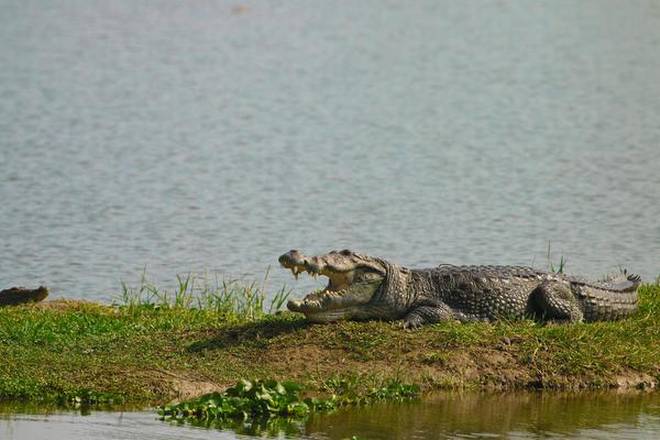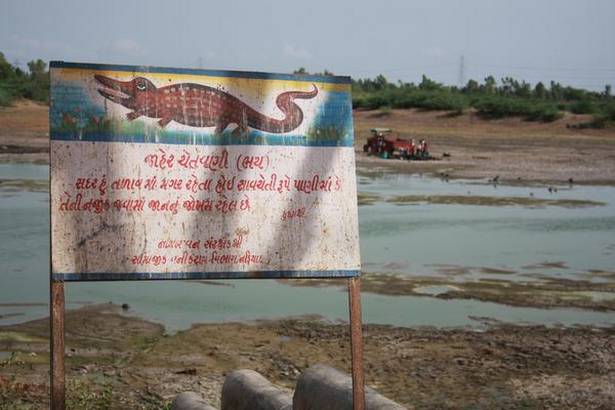
Meet the people of Charotar who love crocodiles not as handbags or shoes but simply as amazing creatures of the wild
Women gather in groups to launder clothes, bathe, and swap gossip along the lapping edge of ponds. Kids beat the afternoon heat by taking a dip in the cool waters. Buffaloes contemplate the gustatory worth of their breakfast sunken in water up to their necks. This is a familiar scene across the subcontinent.
In a region known as the Charotar, south of Ahmedabad, mugger crocodiles live in at least 27 village ponds. In January 2016, Voluntary Nature Conservancy, an NGO, counted more than 100 crocs living among people and their animals.
The residents of the area are a brave breed. If these scaly leviathans gobbled up only feral animals, the people’s laidback attitude would be normal. But these beasts do occasionally snack on goats, calves, and cattle. On rare occasions, they also have the temerity to more than eyeball humans.
The NGO reports four attacks on people between 2009 and 2014 in the Charotar. One was fatal.
You’d expect people in Charotar to throw a fit and demand the removal of these crocodiles. Once in a while they do lose their cool and try to wrest sole possession of their ponds from the crocodiles. To appease the villagers, the Forest Department once removed a few but left the majority in place. Apparently satisfied with this state of affairs, the villagers and the crocs went back to life as usual.
The NGO conducted a survey of what Charotar’s residents felt about the reptiles. More than 80% said they liked muggers. They probably didn’t want to offend any gods. After all, the animal spirit of their regional diety Khodiar Ma is a crocodile. But religious correctness was not the main reason.
The majority of Charotaris replied that they found crocodiles “beautiful”. Across the world, some people fancy crocodiles. Not as handbags or shoes, but as amazing throwbacks to the dinosaur age. It’s rare to find an entire community sold on their reptilian beauty. The villagers weren’t saying this to keep the surveyors happy.
One chap invited the NGO’s volunteers to visit his home in the village of Deva. In his backyard, he pointed to a burrow, the residence of a mugger croc. During the dry season when the water levels drop, muggers dig burrows to escape the heat. Four years ago, the beast had dug a tunnel in the man’s home to stay cool, and since then, every year it turns his backyard into its summer retreat. The villager said he didn’t mind having the creature.
Amiable creatures?
In the neighbouring village of Malataj, residents were even more blasé. They took no special precautions against the predators in their midst. Children played in the water and walked right past the crocodiles without fear.
People who know crocodiles say muggers are generally amiable creatures, unlike saltwater crocodiles that are full of piss and vinegar. But mugger crocs do attack. Only two of the most feisty croc species in the world — the saltie and Nile crocodiles — attack more people than muggers.

According to CrocBITE, a global database of crocodile attacks, mugger crocs attacked 33 people and killed 25 in Nepal, India, and Sri Lanka in 2015. In 2016, they went for 15 and killed 12. In short, the mugger croc is not exactly Bambi in your backyard.
Even as these extraordinary villagers share their homes and ponds with these reptiles, some are louts. They poke the reptiles with sticks, throw stones, and tie them up and play tug. In at least one case, such behaviour traumatised the crocodile, which now charges at anyone who gets close.
If you think villagers of Deva and Malataj are crazy, what would you say of the crocodiles’ behaviour? They don’t have to eat three meals a day. They’d do fine with just one meal a week. Although they take the occasional goat, they don’t seem to attack enough livestock to keep their bodies and souls together. The NGO says tanners flay carcasses of animals and crocs scavenge the remains. In addition, perhaps the predators gorge on fish, wild birds, small mammals, and feral animals such as dogs.
In Malataj, muggers are so tame people call them ‘dung crocodiles’. They think the reptiles eat cow dung since they appear to like lying next to steaming piles of ordure. The NGO says the crocodiles are attracted to the warmth of the dung. Whatever their diet, the crocodiles are healthy and lay fertile eggs every year.
A growing crocodile population ought to be a harbinger of disaster. People use these ponds all day. Men fish, cultivate water chestnuts, and mine sand. The temptation to take a bite of a human arm or leg must be strong. Yet, the predators leave people alone. In January 2013, a croc caught a 34-year-old woman’s hand while she was doing her laundry at the pond in Deva. Perhaps it realised its mistake because it let go immediately.
Forty kilometres away, the situation is very different. An estimated 400 scaly beasts ply the rivers in the vicinity of Vadodara city. In five years, they killed 28 people while 40 escaped with injuries. What makes crocodiles of the same species attack people in one location while giving them a wide berth in another? The answer, when found, could reduce the number of attacks in Vadodara and other such places in this densely packed subcontinent.
I wonder, what do Charotar’s crocs think of their human neighbours? Do they like them? Do they think they are beautiful?
First published by The Hindu